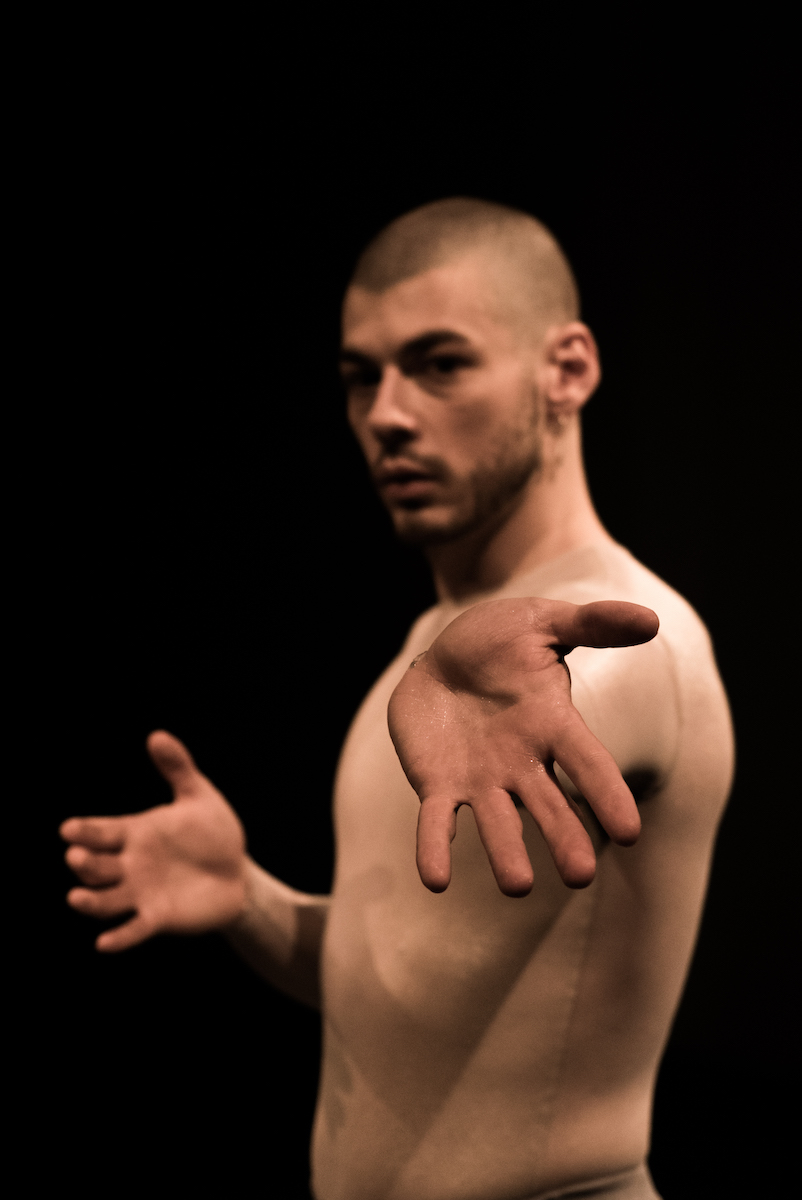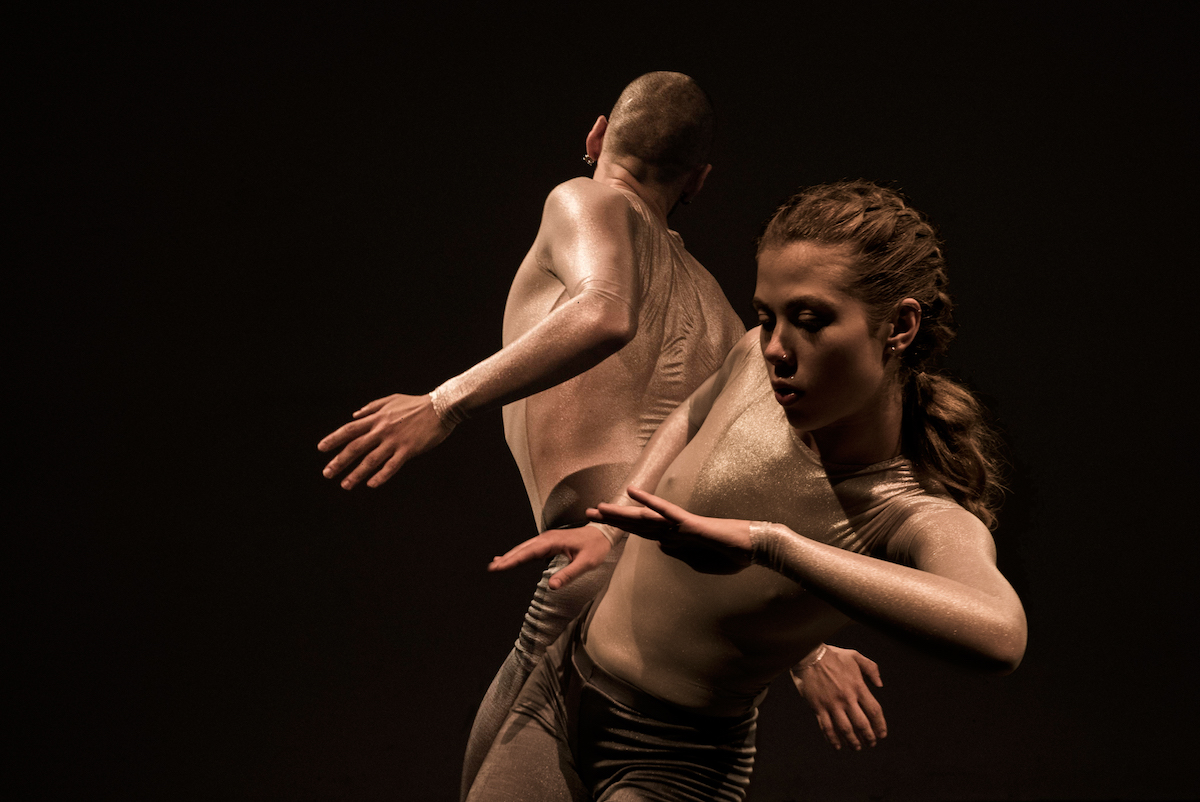Get a hint of the performer and choreographer’s rituals and inner creature.

Can the body’s movement help us untangle identity as a construct? Will it uproot what lies deep behind the social masks we put on? Amsterdam-based performer Moreno Perna would say yes. Or rather, he would show us how through dance.
Last month, we were part of the Italian choreographer’s project, “AURA”—a shamanistic techno ritual, where the audience shared the stage with the dancers. Masterminded by Perna, the performance invited us to sit on the ground, inches away from the performers and immersed in the electrified air. Waves of techno beats washing over us, we first-handedly experienced Perna’s extrasensory mind. Intrigued, Glamcult sat down with him for a chat on the body as shameless receiver, Auratic Practice, and the animalistic spirit in all of us.
Moreno, a very loaded question for a dancer: What does dance mean to you?
Dance can express irrational things; that which you cannot put into words. It goes much deeper than language. Although it’s nonverbal, it’s a very human language, universal and sensitive. So, for me dance is a fragile art form and its humanity is beautiful. Since you need this human interaction, dance reminds humans that they’re human; it’s the beauty and the power of it.
You were just mentioning your interest in rituals and spirituality. Where did that come from?
It’s something that has always been in me. Since my grandma’s passing, I’ve been having a lot of psychic experiences. She’s my main guide through it. [Spirituality] made itself even more visible through dance, because performative art can also achieve that when you enter a certain state. When you dance, the body becomes a vessel and you channel a lot of things through it. That’s the shamanistic part of it, which I use very loosely.
Your performance “AURA” is not just that, it’s also a practice. Could you tell us more about that?
I find that dance is very connected to shamanism or holistic practices, because you can research energies through the body, connect to them, gather and translate them. I’m still working on the development of the Auratic Practice. The performance was, in a way, practising the practice, showcasing it in the format of a dance piece. The next step is to develop it further and give classes, make it more accessible; research on every aura as expression of a specific chakra and its personal and social essence and resolutions.
How does a day of practice in the studio look for you?
When I was working with Evgenia Rubanova, my fellow dancer in “AURA”, we were two weeks in Eindhoven, living, eating, and sleeping there. For me, this is the best way to practice, because you’re there one hundred percent. It’s very important to connect energetically. In the morning in the studio, I take the time to do my own practices and maybe share them with other movers. I do Kundalini meditation, yoga, we often use tarots and other elements to see how the day is going to be. Then, we research the energies for the day for around two hours by doing Auratic Practice, to channel that energy. After the lunch break, we restart from that energy, or go deeper into movement coordination and choreography until we get too tired. Then, we release. Although, one time during our stay there, there was a full moon and we couldn’t sleep, so we did a ritual in the evening.
About how you connect to your audiences during “AURA”, are there any specific interactions that made a lasting imprint?
Yes. In a sense, we’re very close to the audience, because they’re sitting in a circle. During my first research, I avoided it, because I didn’t want to be influenced by people’s energies, and [I wanted to] focus more on what was happening in the space around me. When I decided to do it for the first time, while still working as a solo, I had a moment with a 90-year-old lady who was banging her had on techno music, it was super great. To be honest, the older audience is my favourite; the older the better. They’re so open, so curious and human, not thinking too much. In a way, it’s similar to kids. Another time in September, there was a kid that was sleeping on her mother’s lap on the floor, so close to us. During the performance, she opened her eyes, became more engaged, and started dancing. This is very much an embodiment of what I wish the audience would do—not only watching but also receiving though the body. She did that shamelessly, which I love.
On one of your previous performances, “XYX”, I’ve read that you believe that gender cannot be deconstructed, only transcended. Could you explain that?
Any gender is constructed in a certain culture. You can play with it, like wearing a fictional mask. For “XYX” I tried to dig into how gender is constructed through history in our country. I have the freedom to play with gender expressions and everybody needs that freedom. It was important for me to see that, in the end, what lies beneath gender are spiritual energies, the divine masculine and the divine feminine, and everything in-between. So, the objective was not to focus too much on the gender or the mask, but more on what’s underneath. In the piece, I tried to find the inner creature that’s behind that mask, the spiritual, animalistic, fluid part inside of us. I wanted to go deeper to find the perfect androgyny, which would be my personal ideal.
You mention divine feminine and divine masculine, these conceptions can be problematic, because our cultural perspectives easily mediate our views of them. How do you go about that?
I don’t define divine masculine and divine feminine through qualities, because then they can easily become stereotypical. I do it more through a feeling. That’s why I used dance to express that creature, because those are energies, much more in a non-human sense. It becomes very complicated when you start to try to explain this with words, you immediately make it human-related, and you make it into a binary thing again.

And how do you view your own gender identity?
I’m a queer man. I have fun with gender expression. As a gay man, I always felt confronted by the presupposition that you are feminine no matter what. With dancing, it’s the same problem, because when you’re a male dancer, you’re seen in the same way. So, I felt my coming-out and being a dancer came together, and I accepted that. I’m part feminine, but also part masculine. I don’t want to define what is what, it doesn’t interest me. I wish that everybody carried some more calmness within and were more considerate of the context. If I’m dressed up and someone refers to me as “she”, I don’t mind. My wish for the future is that we won’t have labels anymore; it’s very tiring and annoying. I wish that even the question if you’re a woman or a man would disappear.
Notifications